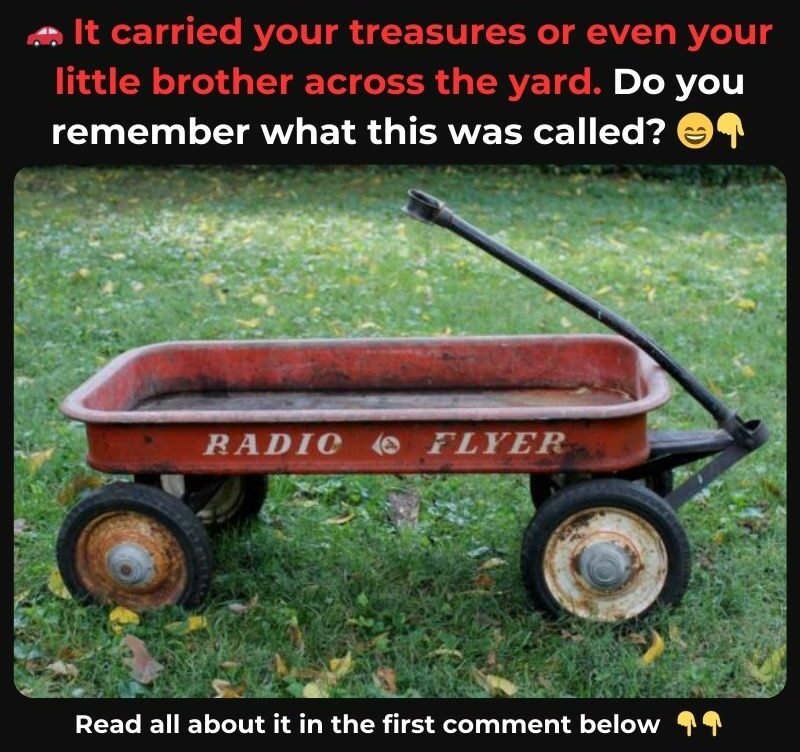The vintage Radio Flyer wagon holds a deep and nostalgic place in the hearts of those who grew up with it, becoming far more than just a childhood toy—it was a symbol of freedom, imagination, and the joy of being a kid. Whether it was used to haul around stuffed animals, carry a picnic to the park, or give younger siblings a ride through the yard, this iconic red wagon was a constant companion for countless American children.

It seemed to always be nearby from the time a child could walk, ready to be filled with treasures and taken on adventures around the neighborhood. What made the vintage Radio Flyer wagon so enduring wasn’t just its utility but the sense of independence and creative play it inspired in every child who had one. Its story began in 1917 when Antonio Pasin, an Italian immigrant, founded the company that would become known as Radio Flyer. Pasin’s vision was to create something simple, sturdy, and joyful for kids. Initially made from wood, the wagons soon shifted to steel construction to increase their durability and lifespan. The vibrant red paint not only stood out visually but also became a signature feature that made the wagons instantly recognizable. By the 1930s, Radio Flyer wagons were household staples across the United States, known for their resilience and timeless appeal.
The company’s name was inspired by the two most exciting innovations of the time—radio and flight—both symbolizing adventure and the limitless possibilities that the red wagon came to represent. As time went on, Radio Flyer continued to improve its wagons, introducing features like rubber tires for smoother rides and more comfortable seating for kids. These upgrades only added to the wagon’s appeal, making it even more versatile and enjoyable. For children, the wagon offered endless possibilities for imaginative play. It could be a race car one day, a pirate ship the next, or a sled during the winter months. It encouraged outdoor activity, cooperative play, and creativity, allowing kids to dream up new adventures every time they grabbed the handle. The wagon was also a practical tool for parents. It helped them carry groceries, gardening tools, or even tired toddlers on family outings.
Its sturdy frame and reliable wheels made it a trusted helper around the home and yard. It was such a common sight in suburban neighborhoods and parks that it became part of the American family experience, often appearing in family photos, parades, and holiday events. More than anything, the Radio Flyer wagon represented a child’s first taste of independence. Being old enough to pull your own wagon filled with whatever you deemed important gave a sense of pride and maturity. It was often the first “vehicle” a child had, a first step toward growing up, and the memories of pulling it down a sunlit sidewalk or through crunchy fall leaves are etched into many childhoods.
The wagon’s influence extended beyond backyards—it made its way into pop culture, appearing in movies, television shows, and advertisements as a timeless symbol of wholesome American childhood. Even as modern toys with flashing lights and digital screens took over store shelves, the Radio Flyer wagon remained beloved. Collectors still seek out vintage models, and many families pass them down through generations, treating them like treasured heirlooms. More than 100 million Radio Flyer wagons have been sold since the company began, and the design has remained largely unchanged—a testament to its perfection. The classic red color was selected not just for visibility, but also for its emotional warmth and nostalgic power. Its success was even cemented in a memorable 1950s commercial that showcased the durability and essential nature of the wagon in every American home. In today’s tech-focused world, the Radio Flyer wagon reminds us of simpler times when play came from imagination and joy came from movement. Its legacy continues in the smiles of children who still pull it behind them and in the hearts of adults who remember what it felt like to have the wind in their hair and the world at their feet, all from the handle of a little red wagon.





